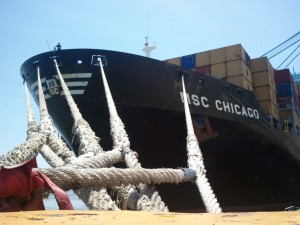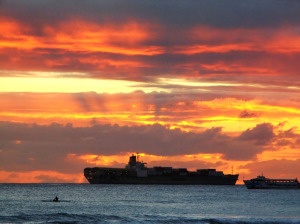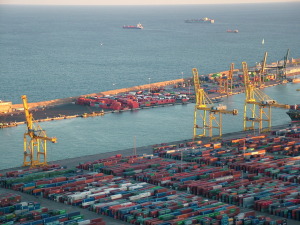 On November 27, 2014, the World Trade Organization (WTO) was finally able to overcome an impasse created by India in July which prevented implementation of the Trade Facilitation Agreement reached in Bali in December 7, 2013. As described by WTO Director General (DG) Azevedo, “the impasse related to the political link between two of the Bali decisions – the decision on Public Stockholding for Food Security Purposes, and the Trade Facilitation Agreement.” The WTO General Council was able to address India’s objections after a breakthrough made by the U.S. and India on November 13, 2014 to simultaneously adopt the protocol necessary to implement the TFA and a decision clarifying the terms of an existing food security “peace clause.”
On November 27, 2014, the World Trade Organization (WTO) was finally able to overcome an impasse created by India in July which prevented implementation of the Trade Facilitation Agreement reached in Bali in December 7, 2013. As described by WTO Director General (DG) Azevedo, “the impasse related to the political link between two of the Bali decisions – the decision on Public Stockholding for Food Security Purposes, and the Trade Facilitation Agreement.” The WTO General Council was able to address India’s objections after a breakthrough made by the U.S. and India on November 13, 2014 to simultaneously adopt the protocol necessary to implement the TFA and a decision clarifying the terms of an existing food security “peace clause.”
News
Trade Facilitation Agreement Is Back On Track

Because of an impasse created by India over food security this past July, which prevented ratification of the Trade Facilitation Agreement (TFA) reached in Bali in December 2013, some questioned the continued viability of the World Trade Organization. On Nov. 27, 2014, the WTO was finally able to overcome the deadlock and adopted the protocol of amendment which opened TFA for ratification and implementation.
The WTO General Council was able to address India’s objections after a breakthrough made by the U.S. and India on Nov. 13, 2014, to simultaneously adopt the protocol necessary to implement the TFA and a decision clarifying the terms of an existing food security “peace clause.” As stated by Director-General Roberto Azevedo, this was “a very important moment for the WTO” putting “negotiations back on track” and creating a “renewed commitment to the multilateral trading system.”
The protocol of amendment formally inserts the TFA into the WTO rulebook, according to Director-General Azevedo. This clears the way for the TFA to come into force. However, it also removes the July 31, 2015, deadline for WTO members to ratify the TFA leaving open the ratification process open indefinitely. The agreement enters into force once two-thirds of WTO members have completed their domestic ratification process.
So what does this first WTO multilateral agreement mean to the global economy, the developing world and international business? U.S. Trade Representative Ambassador Michael Froman says that “[t]he Trade Facilitation Agreement has the potential to fundamentally reform global customs practices and substantially reduce the costs and time associated with goods crossing borders. It’s a perfect example of how breaking down barriers to trade can unlock new opportunities for developed and developing countries alike, and it’s a particularly important win for small- and medium-sized businesses in all countries.” It is no wonder why TFA implementation is strongly supported by groups like the International Chamber of Commerce.
What does the TFA do? The agreement simplifies and harmonizes customs procedures and mandates customs reforms such as introducing transparency, risk based management by customs administrations, a “single window” for all government agencies dealing with imported merchandise, automation, electronic payment of duties and the separation of the payment of duties from the release of cargo, among other things. These improvements are intended to facilitate trade across borders, thereby reducing the costs for international traders and ultimately consumers.
The agreement also offers donor assistance and capacity building to developing and least developing countries so that they can enjoy the well-documented benefits of implementation. The improved trading environment should attract more trade and investment to countries that implement good governance in the form the improved customs procedures. The improvements, which have the effect of increasing transparency and reducing discretion of customs officials, should also address corruption at the border at least to some extent.
So what impact will the customs modernization reforms contained in the TFA have? What does this mean to business engaged in global trade and foreign direct investment? It should introduce an element of predictability in the form of rule of law and good governance for business embarking on what heretofore were riskier trading endeavors. It should take some of the risk out of doing business in emerging markets, where it is said that some of the greatest business opportunities lie. Perhaps even small- and medium-sized businesses will venture out into these markets stimulating the global economy and presenting a win-win for the developed and developing worlds as predicted by Ambassador Froman.
There is much work to be done. The argument must be made that ratification is in each country’s best interest. Countries must be proactive to avail themselves of the assistance offered by donor organizations like the World Bank, World Customs Organization and the WTO, whose Trade Facilitation Agreement Facility is now operational with the finalization of the agreement. Each country must prioritize its most important customs reforms and donor organizations must coordinate efforts to avoid wasting valuable resources. Business can also make their priorities known to the governments and donor organizations on areas of importance to business and what needs to be addressed first in particular countries. As Director-General Azevedo states, now the “real work begins.”
WTO Problems Won’t Stop Trade Facilitation
This article first appeared in Law360 and has been reprinted here with permission.
World Trade Organization Director-General Roberto Azevedo has offered little hope for overcoming the obstacle presented by India in blocking the protocol necessary to finalize the WTO trade facilitation agreement reached in Bali Dec. 7, 2013.[1] Meanwhile, there is a great deal of discussion about what this means for the WTO, but what does it mean for trade facilitation? I would suggest that while this development means a lot to the WTO it means little to trade facilitation. The train has left the station as far as trade facilitation goes because countries and business appreciate the merits of its implementation.
What Trade Facilitation Is and Why It Matters
 The majority of people have heard the old saying: “the early bird gets the worm.” Well, the same holds true for trade facilitation – and there are a few good reasons why.
The majority of people have heard the old saying: “the early bird gets the worm.” Well, the same holds true for trade facilitation – and there are a few good reasons why.
Trade facilitation creates a more efficient supply chain connectivity for improved international trading, builds economic and port infrastructure as well as interconnecting region suppliers in a more fluid and cost-friendly way.
But first, let’s back up a bit and give some history. . .
Addressing Public Corruption is Fundamental to Trade Facilitation
 With the finalization of a Trade Facilitation Agreement (“TFA”) at the conclusion of the 9th Ministerial Conference in Bali, Indonesia, on December 7, 2013 (see: https://mc9.wto.org/system/files/documents/w8_0.pdf), the World Trade Organization (“WTO”) proved that it is not dead. Significantly, the TFA is the first WTO trade agreement concluded since 1998 and the first fully multilateral trade agreement negotiated under the auspices of the WTO. The Organization for Economic Cooperation and Development estimates that these customs reforms would lower the total trade cost of shipping goods by 10 to 15 percent depending upon the country. Some expect implementation of TFA’s measures to boost global trade by an estimated $1 trillion and global GDP by nearly 5 percent. As stated by the Office of the United States Trade Representative, “it makes it easier for businesses big and small to participate in trade around the world – and to support jobs through that trade.” In other words, improved customs procedures and trade facilitation should help all companies, large and small, gain access to new export opportunities by providing predictability, simplicity and uniformity in customs and other border procedures.
With the finalization of a Trade Facilitation Agreement (“TFA”) at the conclusion of the 9th Ministerial Conference in Bali, Indonesia, on December 7, 2013 (see: https://mc9.wto.org/system/files/documents/w8_0.pdf), the World Trade Organization (“WTO”) proved that it is not dead. Significantly, the TFA is the first WTO trade agreement concluded since 1998 and the first fully multilateral trade agreement negotiated under the auspices of the WTO. The Organization for Economic Cooperation and Development estimates that these customs reforms would lower the total trade cost of shipping goods by 10 to 15 percent depending upon the country. Some expect implementation of TFA’s measures to boost global trade by an estimated $1 trillion and global GDP by nearly 5 percent. As stated by the Office of the United States Trade Representative, “it makes it easier for businesses big and small to participate in trade around the world – and to support jobs through that trade.” In other words, improved customs procedures and trade facilitation should help all companies, large and small, gain access to new export opportunities by providing predictability, simplicity and uniformity in customs and other border procedures.
